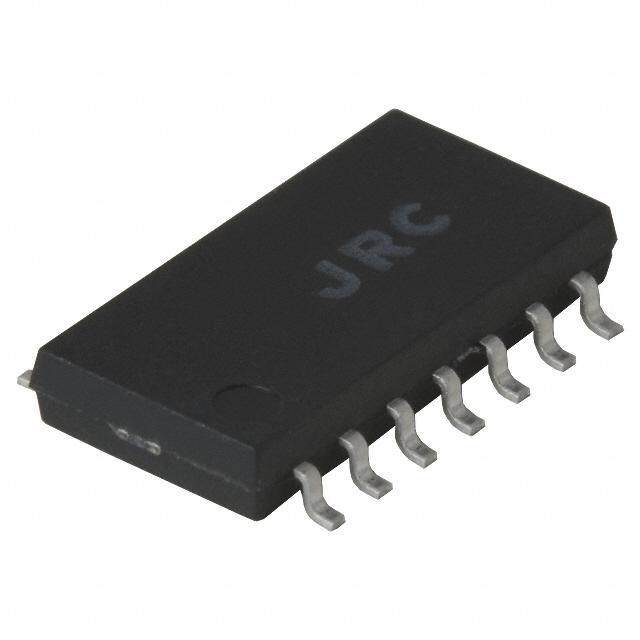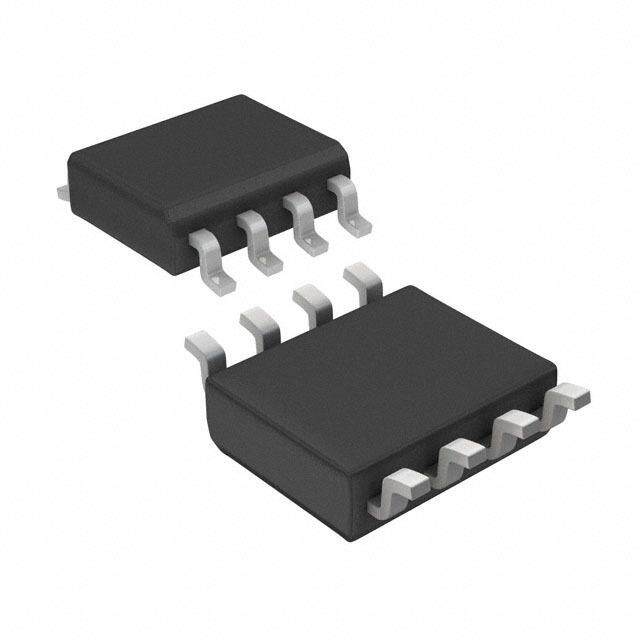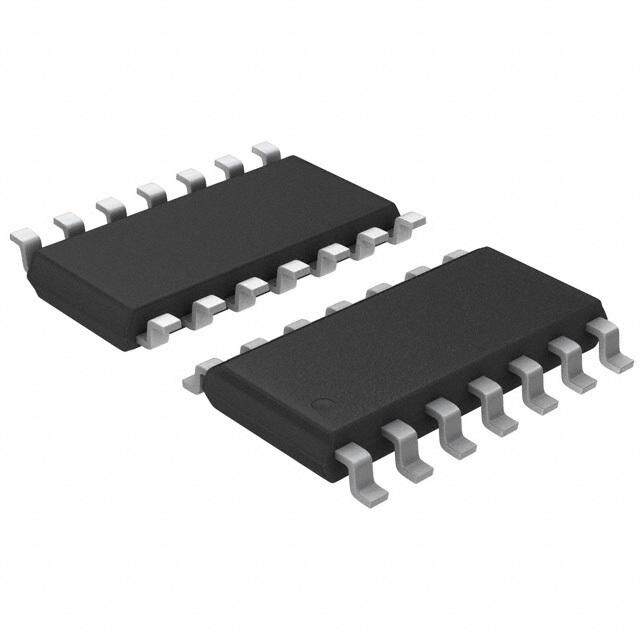ICGOO在线商城 > 集成电路(IC) > 线性 - 放大器 - 仪表,运算放大器,缓冲器放大器 > OPA2333AQDRQ1
- 型号: OPA2333AQDRQ1
- 制造商: Texas Instruments
- 库位|库存: xxxx|xxxx
- 要求:
| 数量阶梯 | 香港交货 | 国内含税 |
| +xxxx | $xxxx | ¥xxxx |
查看当月历史价格
查看今年历史价格
OPA2333AQDRQ1产品简介:
ICGOO电子元器件商城为您提供OPA2333AQDRQ1由Texas Instruments设计生产,在icgoo商城现货销售,并且可以通过原厂、代理商等渠道进行代购。 OPA2333AQDRQ1价格参考。Texas InstrumentsOPA2333AQDRQ1封装/规格:线性 - 放大器 - 仪表,运算放大器,缓冲器放大器, 零漂移 放大器 2 电路 满摆幅 8-SOIC。您可以下载OPA2333AQDRQ1参考资料、Datasheet数据手册功能说明书,资料中有OPA2333AQDRQ1 详细功能的应用电路图电压和使用方法及教程。
OPA2333AQDRQ1 是 Texas Instruments(德州仪器)推出的一款低功耗、高精度运算放大器,属于线性 - 放大器 - 仪表、运算放大器和缓冲器放大器类别。该型号适用于多种精密信号处理场景,以下是一些典型的应用场景: 1. 工业自动化与控制 - OPA2333AQDRQ1 可用于工业控制系统中的传感器信号调理电路。例如,压力传感器、温度传感器或位置传感器的输出信号通常需要经过放大和滤波处理,以提高信噪比并适应后续数据采集系统的要求。 - 在可编程逻辑控制器(PLC)中,它可以用作模拟输入/输出模块的核心元件,确保信号传输的稳定性和准确性。 2. 医疗设备 - 在医疗电子领域,如心电图(ECG)、血压监测仪或血糖仪等设备中,这款运放能够精确放大微弱的生物电信号,同时保持低噪声性能,从而提升诊断结果的可靠性。 - 其低功耗特性也使其非常适合便携式医疗设备的设计。 3. 消费电子产品 - 该器件可用于音频信号处理,例如耳机放大器或麦克风前置放大器,提供高质量的声音还原能力。 - 在智能家居产品中,它可作为环境传感器(如温湿度传感器、光照传感器)的信号调节器,实现更精准的环境监控。 4. 测试测量仪器 - OPA2333AQDRQ1 的高精度和稳定性使其成为示波器、万用表或其他测试设备的理想选择,能够在宽频率范围内准确捕捉和放大信号。 - 它还可用于校准设备,确保测试结果的一致性和重复性。 5. 汽车电子 - 在汽车行业中,这款运放可用于车载传感器信号处理,例如胎压监测系统(TPMS)、发动机控制单元(ECU)或车载娱乐系统的音频放大。 - 其宽工作温度范围(-40°C 至 +125°C)和抗电磁干扰能力,使其在恶劣的汽车环境中表现出色。 6. 通信设备 - 在无线通信模块中,OPA2333AQDRQ1 可用于射频前端的中频信号放大,支持高效的数据传输。 - 它也可应用于物联网(IoT)节点的信号调理电路,优化远程传感和数据采集功能。 总之,OPA2333AQDRQ1 凭借其低功耗、高精度和高可靠性,广泛适用于需要高性能信号处理的各种应用场景,特别是在对精度和稳定性要求较高的领域中表现尤为突出。
| 参数 | 数值 |
| -3db带宽 | - |
| 产品目录 | 集成电路 (IC) |
| 描述 | IC OPAMP ZERO-DRIFT 350KHZ 8SOIC |
| 产品分类 | Linear - Amplifiers - Instrumentation, OP Amps, Buffer Amps |
| 品牌 | Texas Instruments |
| 数据手册 | |
| 产品图片 |
|
| 产品型号 | OPA2333AQDRQ1 |
| rohs | 无铅 / 符合限制有害物质指令(RoHS)规范要求 |
| 产品系列 | - |
| 供应商器件封装 | 8-SOIC |
| 其它名称 | 296-24150-6 |
| 包装 | Digi-Reel® |
| 压摆率 | 0.16 V/µs |
| 增益带宽积 | 350kHz |
| 安装类型 | 表面贴装 |
| 封装/外壳 | 8-SOIC(0.154",3.90mm 宽) |
| 工作温度 | -40°C ~ 125°C |
| 放大器类型 | 零漂移 |
| 标准包装 | 1 |
| 电压-电源,单/双 (±) | 1.8 V ~ 5.5 V, ±0.9 V ~ 2.75 V |
| 电压-输入失调 | 2µV |
| 电流-电源 | 17µA |
| 电流-输入偏置 | 70pA |
| 电流-输出/通道 | 5mA |
| 电路数 | 2 |
| 设计资源 | http://www.digikey.com/product-highlights/cn/zh/texas-instruments-webench-design-center/3176 |
| 输出类型 | 满摆幅 |




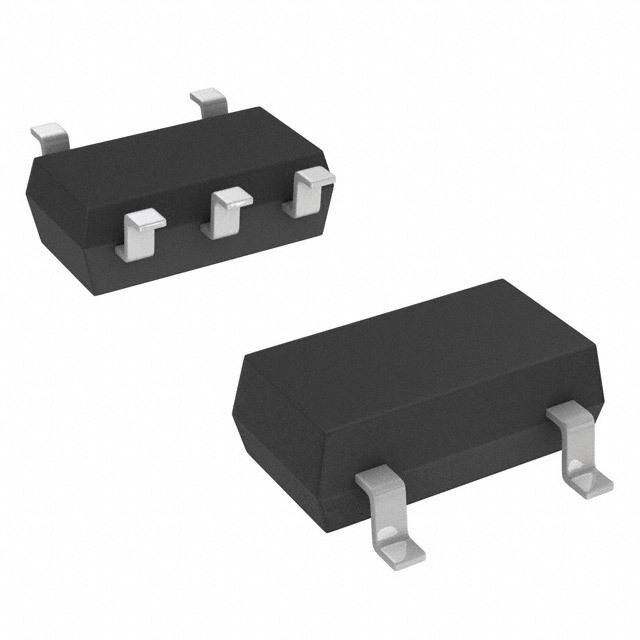



- 商务部:美国ITC正式对集成电路等产品启动337调查
- 曝三星4nm工艺存在良率问题 高通将骁龙8 Gen1或转产台积电
- 太阳诱电将投资9.5亿元在常州建新厂生产MLCC 预计2023年完工
- 英特尔发布欧洲新工厂建设计划 深化IDM 2.0 战略
- 台积电先进制程称霸业界 有大客户加持明年业绩稳了
- 达到5530亿美元!SIA预计今年全球半导体销售额将创下新高
- 英特尔拟将自动驾驶子公司Mobileye上市 估值或超500亿美元
- 三星加码芯片和SET,合并消费电子和移动部门,撤换高东真等 CEO
- 三星电子宣布重大人事变动 还合并消费电子和移动部门
- 海关总署:前11个月进口集成电路产品价值2.52万亿元 增长14.8%
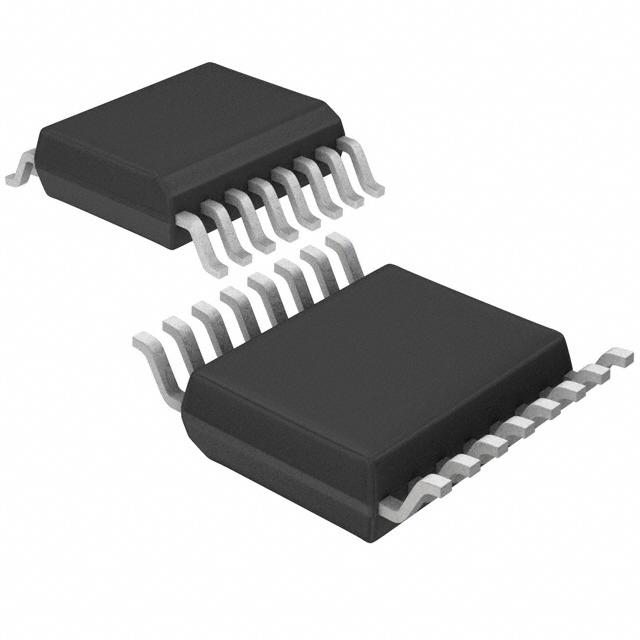


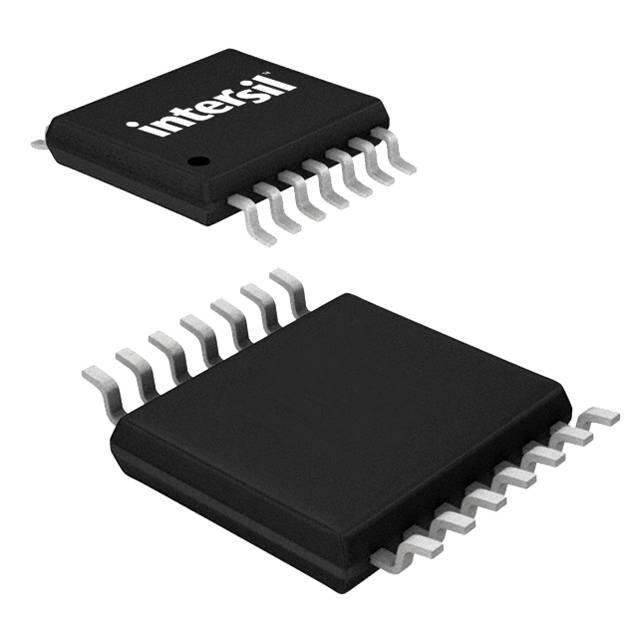

PDF Datasheet 数据手册内容提取
Product Order Technical Tools & Support & Folder Now Documents Software Community OPA2333-Q1 SBOS463B–DECEMBER2008–REVISEDFEBRUARY2020 OPA2333-Q1 Automotive, 1.8-V, Micropower, CMOS, Zero-Drift Operational Amplifier 1 Features 3 Description • AECqualifiedforautomotiveapplications The OPA2333-Q1 CMOS operational amplifiers use a 1 proprietary autocalibration technique to – Temperaturegrade1: –40°Cto+125°C,T A simultaneouslyprovideverylowoffsetvoltage (10 μV, • Lowoffsetvoltage:23 μV(Max) max), and near-zero drift over time and temperature. • 0.01-Hzto10-Hznoise:1.1 μV These miniature high-precision low-quiescent-current PP amplifiers offer high-impedance inputs that have a • Quiescentcurrent:17μA common-mode range 100 mV beyond the rails and • Single-supplyoperation rail-to-rail output that swings within 50 mV of the rails. • Supplyvoltage:1.8Vto5.5V Single or dual supplies as low as 1.8 V (±0.9 V), and up to 5.5 V (±2.75 V) can be used. This device is • Rail-to-railinput/output optimizedforlow-voltagesingle-supplyoperation. • Packages:8-pinSOICandVSSOP The OPA2333-Q1 offers excellent common-mode 2 Applications rejection ratio (CMRR) without the crossover associated with traditional complementary input • Pump stages. This design results in superior performance • Positionsensor for driving analog-to-digital converters (ADCs) without degradationofdifferentiallinearity. • Vehicleoccupantdetectionsensor • Brakesystem The OPA2333-Q1 is specified for operation from –40°Cto+125°C. • Airbag DeviceInformation(1) PARTNUMBER PACKAGE BODYSIZE(NOM) SOIC(8) 4.90mm×3.91mm OPA2333-Q1 VSSOP(8) 3.00mm×3.00mm (1) Forallavailablepackages,seethepackageoptionaddendum attheendofthedatasheet. 0.1-Hzto10-HzNoise v di V/ n 0 0 5 1 s/div 1 An IMPORTANT NOTICE at the end of this data sheet addresses availability, warranty, changes, use in safety-critical applications, intellectualpropertymattersandotherimportantdisclaimers.PRODUCTIONDATA.
OPA2333-Q1 SBOS463B–DECEMBER2008–REVISEDFEBRUARY2020 www.ti.com Table of Contents 1 Features.................................................................. 1 7.4 DeviceFunctionalModes..........................................9 2 Applications........................................................... 1 8 ApplicationandImplementation........................ 10 3 Description............................................................. 1 8.1 ApplicationInformation............................................10 4 RevisionHistory..................................................... 2 8.2 TypicalApplication..................................................11 5 PinConfigurationandFunctions......................... 3 9 PowerSupplyRecommendations...................... 15 6 Specifications......................................................... 4 10 Layout................................................................... 15 6.1 AbsoluteMaximumRatings......................................4 10.1 LayoutGuidelines.................................................15 6.2 ESDRatings..............................................................4 10.2 LayoutExample....................................................15 6.3 RecommendedOperatingConditions.......................4 11 DeviceandDocumentationSupport................. 16 6.4 ThermalInformation..................................................4 11.1 DocumentationSupport........................................16 6.5 ElectricalCharacteristics:V =1.8Vto5.5V..........5 11.2 ReceivingNotificationofDocumentationUpdates16 S 6.6 TypicalCharacteristics..............................................6 11.3 SupportResources...............................................16 7 DetailedDescription.............................................. 9 11.4 Trademarks...........................................................16 7.1 Overview...................................................................9 11.5 ElectrostaticDischargeCaution............................16 7.2 FunctionalBlockDiagram.........................................9 11.6 Glossary................................................................16 7.3 FeatureDescription...................................................9 12 Mechanical,Packaging,andOrderable Information........................................................... 16 4 Revision History ChangesfromRevisionA(June2010)toRevisionB Page • AddedDeviceInformationtable,PinFunctionstable,ESDRatingstable,RecommendedOperatingConditions table,ThermalInformationtable,FeatureDescriptionsection,DeviceFunctionalModessection,Applicationand Implementationsection,PowerSupplyRecommendationssection,Layoutsection,DeviceandDocumentation Supportsection,andMechanical,Packaging,andOrderableInformationsection ............................................................... 1 • Changedinputoffsetvoltage(overfulltemprange)from22µVto15µVinElectricalCharacteristicstable ......................5 • Addedmaximumvalueof0.05µV/°CtotheV driftparameterintheElectricalCharacteristicstable............................... 5 OS • DeletedThermalresistanceparameterfromElectricalCharacteristicstable ....................................................................... 5 2 SubmitDocumentationFeedback Copyright©2008–2020,TexasInstrumentsIncorporated ProductFolderLinks:OPA2333-Q1
OPA2333-Q1 www.ti.com SBOS463B–DECEMBER2008–REVISEDFEBRUARY2020 5 Pin Configuration and Functions DandDGKPackages 8-PinSOICandVSSOP TopView OUT A 1 8 V+ –IN A 2 7 OUT B +IN A 3 6 –IN B V– 4 5 +IN B Not to scale PinFunctions PIN I/O DESCRIPTION NO. NAME 1 OUTA O ChannelAoutput 2 –INA I ChannelAinvertinginput 3 +INA I ChannelAnoninvertinginput 4 V– — Negative(lowest)supplyvoltage 5 +INB I ChannelBnoninvertinginput 6 –INB I ChannelBinvertinginput 7 OUTB O ChannelBoutput 8 V+ — Positive(highest)supplyvoltage Copyright©2008–2020,TexasInstrumentsIncorporated SubmitDocumentationFeedback 3 ProductFolderLinks:OPA2333-Q1
OPA2333-Q1 SBOS463B–DECEMBER2008–REVISEDFEBRUARY2020 www.ti.com 6 Specifications 6.1 Absolute Maximum Ratings overoperatingfree-airtemperaturerange(unlessotherwisenoted)(1) MIN MAX UNIT V Supplyvoltage 7 V CC V Inputvoltage,signalinputpins(2) –0.3 (V+)+0.3 V I Outputshort-circuit(3) Continuous T Operatingfree-airtemperature –40 125 °C A T Operatingvirtual-junctiontemperature 150 °C J T Storagetemperature –65 150 °C stg (1) StressesbeyondthoselistedunderAbsoluteMaximumRatingsmaycausepermanentdamagetothedevice.Thesearestressratings only,whichdonotimplyfunctionaloperationofthedeviceattheseoranyotherconditionsbeyondthoseindicatedunderRecommended OperatingConditions.Exposuretoabsolute-maximum-ratedconditionsforextendedperiodsmayaffectdevicereliability. (2) Inputterminalsarediodeclampedtothepower-supplyrails.Inputsignalsthatcanswingmorethan0.3Vbeyondthesupplyrailsshould becurrentlimitedto10mAorless. (3) Shortcircuittoground,oneamplifierperpackage 6.2 ESD Ratings VALUE UNIT Human-bodymodel(HBM),perAECQ100-002(1) ±2000 HBMESDclassificationlevel2 V Electrostaticdischarge V (ESD) Charged-devicemodel(CDM),perAECQ100-011 ±1000 CDMESDClassificationLevelC6 (1) AECQ100-002indicatesthatHBMstressingshallbeinaccordancewiththeANSI/ESDA/JEDECJS-001specification. 6.3 Recommended Operating Conditions overoperatingfree-airtemperaturerange(unlessotherwisenoted) MIN NOM MAX UNIT V Specifiedsupplyvoltage 1.8 5.5 V S T Specifiedfree-airtemperature –40 125 °C A 6.4 Thermal Information OPA2333-Q1 THERMALMETRIC(1) D(SOIC) DGK(VSSOP) UNIT 8PINS 8PINS R Junction-to-ambientthermalresistance 124.0 180.3 °C/W θJA R Junction-to-case(top)thermalresistance 73.7 48.1 °C/W θJC(top) R Junction-to-boardthermalresistance 64.4 100.9 °C/W θJB ψ Junction-to-topcharacterizationparameter 18.0 2.4 °C/W JT ψ Junction-to-boardcharacterizationparameter 63.9 99.3 °C/W JB R Junction-to-case(bottom)thermalresistance N/A N/A °C/W θJC(bot) (1) Formoreinformationabouttraditionalandnewthermalmetrics,seetheSemiconductorandICPackageThermalMetricsapplication report. 4 SubmitDocumentationFeedback Copyright©2008–2020,TexasInstrumentsIncorporated ProductFolderLinks:OPA2333-Q1
OPA2333-Q1 www.ti.com SBOS463B–DECEMBER2008–REVISEDFEBRUARY2020 6.5 Electrical Characteristics: V = 1.8 V to 5.5 V S AtT =25°C,R =10kΩconnectedtoV /2,V =V /2,andV =V /2(unlessotherwisenoted). A L S CM S OUT S PARAMETER TESTCONDITIONS MIN TYP MAX UNIT OFFSETVOLTAGE V =5V 2 10 μV S V Inputoffsetvoltage OS V =5V,T =–40°Cto+125°C 15 μV S A dV /d V drift V =5V,T =–40°Cto125°C 0.02 0.05 μV/°C OS T OS S A V =1.8Vto5.5V, PSRR Power-supplyrejectionratio S 1 6 μV/V T =–40°Cto+125°C A Long-termstability(1) 1(1) µV Channelseparation,dc 0.1 μV/V INPUTBIASCURRENT ±70 ±200 pA I Inputbiascurrent B T =–40°Cto+125°C ±150 pA A I Inputoffsetcurrent ±140 ±400 pA OS NOISE f=0.01Hzto1Hz 0.3 μV PP Inputvoltagenoise f=0.1Hzto10Hz 1.1 μV PP i Inputcurrentnoise f=10Hz 100 fA/√Hz n INPUTVOLTAGE V Common-modesupplyvoltage (V–)–0.1 (V+)+0.1 V CM (V–)–0.1V<V <(V+)+0.1V, CMRR Common-moderejectionratio CM 102 130 dB T =–40°Cto+125°C A INPUTCAPACITANCE Differential 2 pF Common-mode 4 pF OPEN-LOOPGAIN (V–)+100mV<V <(V+)–100mV, A Open-loopvoltagegain O 104 130 dB OL R =10kΩ,T =–40°Cto+125°C L A FREQUENCYRESPONSE GBW Gain-bandwidthproduct C =100pF 350 kHz L SR Slewrate G=1 0.16 V/μs OUTPUT R =10kΩ 30 50 mV L Voltageoutputswingfromrail R =10kΩ,T =–40°Cto+125°C 85 mV L A I Short-circuitcurrent ±5 mA SC C Capacitiveloaddrive L (2)Open-loopoutputimpedance f=350kHz,I =0A 2 kΩ O POWERSUPPLY I =0A 17 25 μA O I Quiescentcurrentperamplifier Q I =0A,T =–40°Cto+125°C 30 μA O A Turn-ontime V =5V 100 μs S (1) 300-hourlifetestat150°Cdemonstratedrandomlydistributedvariationofapproximately1μV. (2) SeetheTypicalCharacteristicssection. Copyright©2008–2020,TexasInstrumentsIncorporated SubmitDocumentationFeedback 5 ProductFolderLinks:OPA2333-Q1
OPA2333-Q1 SBOS463B–DECEMBER2008–REVISEDFEBRUARY2020 www.ti.com 6.6 Typical Characteristics AtT =25°C,V =5V,andC =0pF(unlessotherwisenoted) A S L n n o o ati ati ul ul p p o o P P 098765432101234567890 050505050505050505050 1−−−−−−−−− 1 25702570257025702570 − 00011112222333344445 00000000000000000000 Offset Voltage (µV) 0.0.0.0.0.0.0.0.0.0.0.0.0.0.0.0.0.0.0.0. Offset Voltage Drift (µV/°C) Figure1.OffsetVoltageProductionDistribution Figure2.OffsetVoltageDriftProductionDistribution 120 250 140 100 200 120 80 150 100 (dB) 60 100 se (°) R (dB) 80 AOL 40 50 Pha CMR 60 20 0 40 0 −50 20 −20 −100 0 10 100 1k 10k 100k 1M 1 10 100 1k 10k 100k 1M Frequency (Hz) Frequency (Hz) Figure3.Open-LoopGainvsFrequency Figure4.Common-ModeRejectionRatiovsFrequency 120 3 V =±2.75V +PSRR S V =±0.9V S 100 2 −PSRR −40°C 80 V) 1 R(dB) 60 Swing( 0 +125°C +25°C PSR 40 utput −1 +25°C −40°C O +125°C +25°C 20 −2 −40°C 0 −3 1 10 100 1k 10k 100k 1M 0 1 2 3 4 5 6 7 8 9 10 Frequency(Hz) OutputCurrent(mA) Figure5.Power-SupplyRejectionRangevsFrequency Figure6.OutputVoltageSwingvsOutputCurrent 6 SubmitDocumentationFeedback Copyright©2008–2020,TexasInstrumentsIncorporated ProductFolderLinks:OPA2333-Q1
OPA2333-Q1 www.ti.com SBOS463B–DECEMBER2008–REVISEDFEBRUARY2020 Typical Characteristics (continued) AtT =25°C,V =5V,andC =0pF(unlessotherwisenoted) A S L 100 200 V =5.5 V 80 S 60 −IB 150 −IB VS=1.8 V 100 4200 VS= 5 V 50 −IB A) A) p 0 p 0 I(B −20 I(B −50 +IB −40 −100 −60 +IB −150 +IB −80 −100 −200 0 1 2 3 4 5 −50 −25 0 25 50 75 100 125 Common-Mode Voltage (V) Temperature (°C) Figure7.InputBiasCurrentvsCommon-ModeVoltage Figure8.InputBiasCurrentvsTemperature 25 G=1 R =10kΩ L 20 v) VS=5.5V V/di 1 A) 15 ge ( µ V =1.8V a I(Q 10 S ut Volt p ut O 5 0 −50 −25 0 25 50 75 100 125 Time (50 µs/div) Temperature (°C) Figure9.QuiescentCurrentvsTemperature Figure10.Large-SignalStepResponse G=+1 v RL=10kΩ V/di 0 div) 2 Input V/ m 0 Output 5 e ( g olta 10 kW V Output V/div 0 1 kW D+1e2/v2.i5ceV 1 –2.5V Time (5 µs/div) Time(50 µs/div) Figure11.Small-SignalStepResponse Figure12.PositiveOver-VoltageRecovery Copyright©2008–2020,TexasInstrumentsIncorporated SubmitDocumentationFeedback 7 ProductFolderLinks:OPA2333-Q1
OPA2333-Q1 SBOS463B–DECEMBER2008–REVISEDFEBRUARY2020 www.ti.com Typical Characteristics (continued) AtT =25°C,V =5V,andC =0pF(unlessotherwisenoted) A S L 600 4VStep Input 500 v di 2V/ 0 µ(s) 400 e m 0 Ti 300 div 10kW ng 1V/ 1 kW +2.5V Settli 200 Output 0.001% 1/2 Device 100 0.01% –2.5V 0 Time (50 µs/div) 1 10 100 Gain(dB) Figure13.NegativeOver-VoltageRecovery Figure14.SettlingTimevsClosed-LoopGain 40 35 30 %) 25 v ( di ot V/ o 20 n versh 15 500 O 10 5 0 10 100 1000 1s/div LoadCapacitance(pF) Figure15.Small-SignalOvershootvsLoadCapacitance Figure16.0.1-Hzto10-HzNoise 1000 1000 Hz) Continueswithno1/f(flicker)noise. Hz) V// A// (n CurrentNoise (f e e Nois 100 100 Nois Voltage VoltageNoise Current 10 10 1 10 100 1k 10k Frequency(Hz) Figure17.CurrentandVoltageSpectralDensityvsFrequency 8 SubmitDocumentationFeedback Copyright©2008–2020,TexasInstrumentsIncorporated ProductFolderLinks:OPA2333-Q1
OPA2333-Q1 www.ti.com SBOS463B–DECEMBER2008–REVISEDFEBRUARY2020 7 Detailed Description 7.1 Overview The OPA2333-Q1 device is a zero-drift, low-power, rail-to-rail input and output operational amplifier. The device operates from 1.8 V to 5.5 V, is unity-gain stable, and is designed for a wide range of general-purpose applications.Thezero-driftarchitectureprovidesultra-lowoffsetvoltageandnear-zerooffsetvoltagedrift. The OPA2333-Q1 is unity-gain stable and free from unexpected output phase reversal. The device uses a proprietaryauto-calibrationtechniquetoprovidelowoffsetvoltageandverylowdriftovertimeandtemperature. 7.2 Functional Block Diagram C2 Notch CHOP1 GM1 CHOP2 Filter GM2 GM3 +IN OUT –IN GM_FF C1 7.3 Feature Description 7.3.1 Rail-to-RailInputVoltage The OPA2333-Q1 input common-mode voltage range extends 0.1 V beyond the supply rails. The device is designed to cover the full range without the troublesome transition region found in some other rail-to-rail amplifiers. Normally, input bias current is approximately 70 pA; however, input voltages exceeding the power supplies can cause excessive current to flow into or out of the input pins. Momentary voltages greater than the power supply can be tolerated if the input current is limited to 10 mA. This limitation is easily accomplished with an input resistor(seeFigure18). +5V I OVERLOAD 10 mA max 1/2 OPA2333 V OUT V IN 5 kW (see Note) NOTE: Acurrent-limitingresistorrequirediftheinputvoltageexceedsthesupplyrailsby≥0.5V. Figure18. InputCurrentProtection 7.3.2 InternalOffsetCorrection The OPA2333-Q1 op amps use an auto-calibration technique with a time-continuous 350-kHz op amp in the signal path. This amplifier is zero corrected every 8 μs using a proprietary technique. At power up, the amplifier requiresapproximately100μstoachievethespecifiedV accuracy.Thisdesignhasnoaliasingorflickernoise. OS 7.4 Device Functional Modes The OPA2333-Q1 has a single functional mode. The device is powered on as long as the power-supply voltage isbetween1.8V(±0.9V)and5.5V(±2.75V). Copyright©2008–2020,TexasInstrumentsIncorporated SubmitDocumentationFeedback 9 ProductFolderLinks:OPA2333-Q1
OPA2333-Q1 SBOS463B–DECEMBER2008–REVISEDFEBRUARY2020 www.ti.com 8 Application and Implementation NOTE Information in the following applications sections is not part of the TI component specification, and TI does not warrant its accuracy or completeness. TI’s customers are responsible for determining suitability of components for their purposes. Customers should validateandtesttheirdesignimplementationtoconfirmsystemfunctionality. 8.1 Application Information The OPA2333-Q1 is a unity-gain stable, precision operational amplifier with very low offset voltage drift. The device is also free from output phase reversal. Applications with noisy or high-impedance power supplies require decouplingcapacitorsclosetothedevicepower-supplypins.Inmostcases,0.1-μFcapacitorsareadequate. 8.1.1 AchievingOutputSwingtotheOpAmpNegativeRail Some applications require output voltage swings from 0 V to a positive full-scale voltage (such as 2.5 V) with excellent accuracy. With most single-supply op amps, problems arise when the output signal approaches 0 V, near the lower output swing limit of a single-supply op amp. A good single-supply op amp may swing close to single-supply ground, but does not reach ground. The output of the OPA2333-Q1 can be made to swing to ground or slightly below on a single-supply power source. To do so requires the use of another resistor and an additional, more negative, power supply than the op amp negative supply. A pulldown resistor may be connected between the output and the additional negative supply to pull the output down below the value that the output wouldotherwiseachieve(seeFigure19). V+ = 5 V 1/2 OPA2333 VOUT VIN RP 20 k(cid:13) Op Amp V† = Ground (cid:239)5 V Additional Negative Supply Figure19. V RangetoGround OUT The OPA2333-Q1 has an output stage that allows the output voltage to be pulled to its negative supply rail, or slightly below, using the technique previously described. This technique only works with some types of output stages. The OPA2333-Q1 has been characterized to perform with this technique; however, the recommended resistorvalueisapproximately20kΩ. NOTE Thisconfigurationincreasesthecurrentconsumptionbyseveralhundredsofmicroamps. Accuracy is excellent down to 0 V and as low as –2 mV. Limiting and nonlinearity occurs below –2 mV, but excellent accuracy returns as the output is again driven above –2 mV. Lowering the resistance of the pulldown resistor allows the op amp to swing even further below the negative rail. Resistances as low as 10 kΩ can be usedtoachieveexcellentaccuracydownto–10mV. 10 SubmitDocumentationFeedback Copyright©2008–2020,TexasInstrumentsIncorporated ProductFolderLinks:OPA2333-Q1
OPA2333-Q1 www.ti.com SBOS463B–DECEMBER2008–REVISEDFEBRUARY2020 8.2 Typical Application 8.2.1 High-SideVoltage-to-Current(V-I)Converter ThecircuitshowninFigure20isahigh-sidevoltage-to-current(V-I)converter.It translates in input voltage of 0 V to 2 V to and output current of 0 mA to 100 mA. Figure 21 shows the measured transfer function for this circuit. ThelowoffsetvoltageandoffsetdriftoftheOPA333-Q1devicefacilitateexcellentdcaccuracyforthecircuit. V+ 470R S(cid:13)2 IRS2 4.7R S(cid:13)3 IRS3 R4 VRS2 10 k(cid:13) VRS3 C7 2200 pF R5 330 (cid:13) A2 + Q2 V+ R3 + 200 (cid:13) Q1 A1 + VIN – C6 10R k2(cid:13) 1000 pF VRS1 VLOAD 2R kS(cid:13)1 IRS1 RLOAD ILOAD Figure20. High-SideVoltage-to-Current(V-I)Converter Copyright©2008–2020,TexasInstrumentsIncorporated SubmitDocumentationFeedback 11 ProductFolderLinks:OPA2333-Q1
OPA2333-Q1 SBOS463B–DECEMBER2008–REVISEDFEBRUARY2020 www.ti.com Typical Application (continued) 8.2.1.1 DesignRequirements Thedesignrequirementsareasfollows: • Supplyvoltage:5Vdc • Input:0Vto2Vdc • Output:0mAto100mAdc 8.2.1.2 DetailedDesignProcedure The V-I transfer function of the circuit is based on the relationship between the input voltage, V , and the three IN current sensing resistors, R , R , and R . The relationship between V and R determines the current that S1 S2 S3 IN S1 flows through the first stage of the design. The current gain from the first stage to the second stage is based on therelationshipbetweenR andR . S2 S3 For a successful design, pay close attention to the dc characteristics of the operational amplifier chosen for the application. To meet the performance goals, this application benefits from an operational amplifier with low offset voltage, low temperature drift, and rail-to-rail output. The OPA2333-Q1 CMOS operational amplifier is a high- precision, 5-µV offset, 0.05-μV/°C drift amplifier optimized for low-voltage, single-supply operation with an output swingtowithin50mV of the positive rail. The OPA2333-Q1 uses chopping techniques to provide low initial offset voltage and near-zero drift over time and temperature. Low offset voltage and low drift reduce the offset error in the system, making these devices appropriate for precise dc control. The rail-to-rail output stage of the OPA2333-Q1 makes sure that the output swing of the operational amplifier is able to fully control the gate of the MOSFETdeviceswithinthesupplyrails. A detailed error analysis, design procedure, and additional measured results are given in the High-Side V-I Converter referencedesign. 8.2.1.3 ApplicationCurve 0.1 Load 0.075 A) nt ( e urr0.05 C ut p ut O 0.025 0 0 0.5 1 1.5 2 Input Voltage (V) D001 Figure21. MeasuredTransferFunctionforHigh-SideV-IConverter 12 SubmitDocumentationFeedback Copyright©2008–2020,TexasInstrumentsIncorporated ProductFolderLinks:OPA2333-Q1
OPA2333-Q1 www.ti.com SBOS463B–DECEMBER2008–REVISEDFEBRUARY2020 Typical Application (continued) 8.2.1.4 SingleOpAmpBridgeAmplifier Figure22showsthebasicconfigurationforabridgeamplifier. V EX R 1 +5V R R R R 1/2 OPA2333 VOUT R 1 V REF Figure22. SingleOp-AmpBridgeAmplifier 8.2.1.5 Low-SideCurrentMonitor A low-side current shunt monitor is shown in Figure 23. R are operational resistors used to isolate the ADS1100 N from the noise of the digital I2C bus. Because the ADS1100 is a 16-bit converter, a precise reference is essential for maximum accuracy. If absolute accuracy is not required, and the 5-V power supply is sufficiently stable, the REF3130maybeomitted. 3V 5V REF3130 Load R R 1 2 4.99k: 49.9k: R V 716.5k: 5R6N: ILOAD R1S:HUNT OP1A/22333 4.9R93k: 48.7R4k: ADS1100 5R6N: I2C StrayGround-LoopResistance R7 (PGAGain=4) 1.18k: FS=3.0V NOTE: 1%resistorsprovideadequatecommon-moderejectionatsmallground-looperrors. Figure23. Low-SideCurrentMonitor Copyright©2008–2020,TexasInstrumentsIncorporated SubmitDocumentationFeedback 13 ProductFolderLinks:OPA2333-Q1
OPA2333-Q1 SBOS463B–DECEMBER2008–REVISEDFEBRUARY2020 www.ti.com Typical Application (continued) 8.2.1.6 High-SideCurrentMonitor Figure24showstheusecaseforaprecisionsingle-supplyamplifierforahigh-sidecurrentsensingcircuit. R G zener(A) V+ R SHUNT R1(B) 1/2 MOSFETratedto 10k: OPA2333 standoffsupplyvoltage suchasBSS84for upto50 V. +5V V+ Twozener biasingmethods areshown.(C) Output Load R BIAS R L A. Zenerratedforopampsupplycapability(thatis,5.1VfortheOPA2333). B. Current-limitingresistor. C. ChooseaZenerbiasingresistorordualNMOSFETs(FDG6301N,NTJD4001N,orSi1034). Figure24. High-SideCurrentMonitor 8.2.1.7 PrecisionInstrumentationAmplifier Figure25showsathreeopampimplementationforahigh-CMRRinstrumentationamplifier.. V (cid:239)In1 1/2 OPA333 OPA2333 2 5 R 2 6 R V 1 O R 2 3 1 1/2 OPA2333 V 2 +In V =(1+2R/R )(V (cid:239)V ) O 2 1 2 1 Figure25. PrecisionInstrumentationAmplifier 14 SubmitDocumentationFeedback Copyright©2008–2020,TexasInstrumentsIncorporated ProductFolderLinks:OPA2333-Q1
OPA2333-Q1 www.ti.com SBOS463B–DECEMBER2008–REVISEDFEBRUARY2020 9 Power Supply Recommendations The OPA2333-Q1 is specified for operation from 1.8 V to 5.5 V (±0.9 V to ±2.75 V); many specifications apply from –40°C to +125°C. The Typical Characteristics section presents parameters that can exhibit significant variancewithregardtooperatingvoltageortemperature. CAUTION Supply voltages greater than 7 V can permanently damage the device (see the AbsoluteMaximumRatingstable). Place 0.1-μF bypass capacitors near the power-supply pins to reduce coupling errors from noisy or high- impedancepowersupplies.Formoredetailsonbypasscapacitorplacement,seetheLayoutsection. 10 Layout 10.1 Layout Guidelines Pay attention to good layout practices. Keep traces short and when possible, use a printed-circuit-board (PCB) ground plane with surface-mount components placed as close to the device pins as possible. Place a 0.1-μF capacitor closely across the supply pins. Apply these guidelines throughout the analog circuit to improve performanceandprovidebenefits,suchasreducingtheelectromagneticinterference(EMI)susceptibility. Operational amplifiers vary in susceptibility to radio frequency interference (RFI). RFI can generally be identified as a variation in offset voltage or dc signal levels with changes in the interfering RF signal. The OPA2333-Q1 is specifically designed to minimize susceptibility to RFI and demonstrates remarkably low sensitivity compared to previousgenerationdevices.StrongRFfieldsmaystillcausevaryingoffsetlevels. For lowest offset voltage and precision performance, optimize circuit layout and mechanical conditions. Avoid temperature gradients that create thermoelectric (Seebeck) effects in the thermocouple junctions formed from connecting dissimilar conductors. Cancel these thermally-generated potentials by assuring they are equal on bothinputterminals.Otherlayoutanddesignconsiderationsinclude: • Uselow-thermoelectric-coefficientconnections(avoiddissimilarmetals). • Thermallyisolatecomponentsfrompowersuppliesorotherheatsources. • Shieldoperationalamplifierandinputcircuitryfromaircurrents,suchascoolingfans. Following these guidelines reduces the likelihood of junctions being at different temperatures, which can cause thermoelectricvoltagesof0.1μV/°Corhigher,dependingonmaterialsused. 10.2 Layout Example Place components close Run the input traces to device and to each VS+ as far away from other to reduce parasitic the supply lines errors as possible RF NC NC Use a low-ESR, RG ceramic bypass GND –IN V+ capacitor VIN +IN OUTPUT V– NC GND VS– GND VOUT Ground (GND) plane on another layer Use low-ESR, ceramic bypass capacitor Figure26. LayoutExample Copyright©2008–2020,TexasInstrumentsIncorporated SubmitDocumentationFeedback 15 ProductFolderLinks:OPA2333-Q1
OPA2333-Q1 SBOS463B–DECEMBER2008–REVISEDFEBRUARY2020 www.ti.com 11 Device and Documentation Support 11.1 Documentation Support 11.1.1 RelatedDocumentation Forrelateddocumentationseethefollowing: • TexasInstruments,ADS1100Self-Calibrating,16-BitAnalog-to-DigitalConverter datasheet • TexasInstruments,REF31xx15ppm/°CMaximum,100-μA,SOT-23SeriesVoltageReference datasheet • TexasInstruments,INAx321microPower,Single-Supply,CMOSInstrumentationAmplifier datasheet • TexasInstruments,INA32xPrecision,Rail-to-RailI/OInstrumentationAmplifier datasheet 11.2 Receiving Notification of Documentation Updates To receive notification of documentation updates, navigate to the device product folder on ti.com. In the upper right corner, click on Alert me to register and receive a weekly digest of any product information that has changed.Forchangedetails,reviewtherevisionhistoryincludedinanyreviseddocument. 11.3 Support Resources TI E2E™ support forums are an engineer's go-to source for fast, verified answers and design help — straight fromtheexperts.Searchexistinganswersoraskyourownquestiontogetthequickdesignhelpyouneed. Linked content is provided "AS IS" by the respective contributors. They do not constitute TI specifications and do notnecessarilyreflectTI'sviews;seeTI'sTermsofUse. 11.4 Trademarks E2EisatrademarkofTexasInstruments. Allothertrademarksarethepropertyoftheirrespectiveowners. 11.5 Electrostatic Discharge Caution This integrated circuit can be damaged by ESD. Texas Instruments recommends that all integrated circuits be handled with appropriateprecautions.Failuretoobserveproperhandlingandinstallationprocedurescancausedamage. ESDdamagecanrangefromsubtleperformancedegradationtocompletedevicefailure.Precisionintegratedcircuitsmaybemore susceptibletodamagebecauseverysmallparametricchangescouldcausethedevicenottomeetitspublishedspecifications. 11.6 Glossary SLYZ022—TIGlossary. Thisglossarylistsandexplainsterms,acronyms,anddefinitions. 12 Mechanical, Packaging, and Orderable Information The following pages include mechanical, packaging, and orderable information. This information is the most current data available for the designated devices. This data is subject to change without notice and revision of thisdocument.Forbrowser-basedversionsofthisdatasheet,refertotheleft-handnavigation. 16 SubmitDocumentationFeedback Copyright©2008–2020,TexasInstrumentsIncorporated ProductFolderLinks:OPA2333-Q1
PACKAGE OPTION ADDENDUM www.ti.com 6-Feb-2020 PACKAGING INFORMATION Orderable Device Status Package Type Package Pins Package Eco Plan Lead/Ball Finish MSL Peak Temp Op Temp (°C) Device Marking Samples (1) Drawing Qty (2) (6) (3) (4/5) OPA2333AQDGKRQ1 ACTIVE VSSOP DGK 8 2500 Green (RoHS NIPDAU Level-3-260C-168 HR OCOQ & no Sb/Br) OPA2333AQDRQ1 ACTIVE SOIC D 8 2500 Green (RoHS NIPDAU Level-1-260C-UNLIM -40 to 125 02333Q & no Sb/Br) (1) The marketing status values are defined as follows: ACTIVE: Product device recommended for new designs. LIFEBUY: TI has announced that the device will be discontinued, and a lifetime-buy period is in effect. NRND: Not recommended for new designs. Device is in production to support existing customers, but TI does not recommend using this part in a new design. PREVIEW: Device has been announced but is not in production. Samples may or may not be available. OBSOLETE: TI has discontinued the production of the device. (2) RoHS: TI defines "RoHS" to mean semiconductor products that are compliant with the current EU RoHS requirements for all 10 RoHS substances, including the requirement that RoHS substance do not exceed 0.1% by weight in homogeneous materials. Where designed to be soldered at high temperatures, "RoHS" products are suitable for use in specified lead-free processes. TI may reference these types of products as "Pb-Free". RoHS Exempt: TI defines "RoHS Exempt" to mean products that contain lead but are compliant with EU RoHS pursuant to a specific EU RoHS exemption. Green: TI defines "Green" to mean the content of Chlorine (Cl) and Bromine (Br) based flame retardants meet JS709B low halogen requirements of <=1000ppm threshold. Antimony trioxide based flame retardants must also meet the <=1000ppm threshold requirement. (3) MSL, Peak Temp. - The Moisture Sensitivity Level rating according to the JEDEC industry standard classifications, and peak solder temperature. (4) There may be additional marking, which relates to the logo, the lot trace code information, or the environmental category on the device. (5) Multiple Device Markings will be inside parentheses. Only one Device Marking contained in parentheses and separated by a "~" will appear on a device. If a line is indented then it is a continuation of the previous line and the two combined represent the entire Device Marking for that device. (6) Lead/Ball Finish - Orderable Devices may have multiple material finish options. Finish options are separated by a vertical ruled line. Lead/Ball Finish values may wrap to two lines if the finish value exceeds the maximum column width. Important Information and Disclaimer:The information provided on this page represents TI's knowledge and belief as of the date that it is provided. TI bases its knowledge and belief on information provided by third parties, and makes no representation or warranty as to the accuracy of such information. Efforts are underway to better integrate information from third parties. TI has taken and continues to take reasonable steps to provide representative and accurate information but may not have conducted destructive testing or chemical analysis on incoming materials and chemicals. TI and TI suppliers consider certain information to be proprietary, and thus CAS numbers and other limited information may not be available for release. In no event shall TI's liability arising out of such information exceed the total purchase price of the TI part(s) at issue in this document sold by TI to Customer on an annual basis. Addendum-Page 1
PACKAGE OPTION ADDENDUM www.ti.com 6-Feb-2020 OTHER QUALIFIED VERSIONS OF OPA2333-Q1 : •Catalog: OPA2333 NOTE: Qualified Version Definitions: •Catalog - TI's standard catalog product Addendum-Page 2
PACKAGE MATERIALS INFORMATION www.ti.com 3-Aug-2017 TAPE AND REEL INFORMATION *Alldimensionsarenominal Device Package Package Pins SPQ Reel Reel A0 B0 K0 P1 W Pin1 Type Drawing Diameter Width (mm) (mm) (mm) (mm) (mm) Quadrant (mm) W1(mm) OPA2333AQDGKRQ1 VSSOP DGK 8 2500 330.0 12.4 5.3 3.3 1.3 8.0 12.0 Q1 OPA2333AQDRQ1 SOIC D 8 2500 330.0 12.4 6.4 5.2 2.1 8.0 12.0 Q1 PackMaterials-Page1
PACKAGE MATERIALS INFORMATION www.ti.com 3-Aug-2017 *Alldimensionsarenominal Device PackageType PackageDrawing Pins SPQ Length(mm) Width(mm) Height(mm) OPA2333AQDGKRQ1 VSSOP DGK 8 2500 370.0 355.0 55.0 OPA2333AQDRQ1 SOIC D 8 2500 367.0 367.0 35.0 PackMaterials-Page2
PACKAGE OUTLINE D0008A SOIC - 1.75 mm max height SCALE 2.800 SMALL OUTLINE INTEGRATED CIRCUIT C SEATING PLANE .228-.244 TYP [5.80-6.19] .004 [0.1] C A PIN 1 ID AREA 6X .050 [1.27] 8 1 2X .189-.197 [4.81-5.00] .150 NOTE 3 [3.81] 4X (0 -15 ) 4 5 8X .012-.020 B .150-.157 [0.31-0.51] .069 MAX [3.81-3.98] .010 [0.25] C A B [1.75] NOTE 4 .005-.010 TYP [0.13-0.25] 4X (0 -15 ) SEE DETAIL A .010 [0.25] .004-.010 0 - 8 [0.11-0.25] .016-.050 [0.41-1.27] DETAIL A (.041) TYPICAL [1.04] 4214825/C 02/2019 NOTES: 1. Linear dimensions are in inches [millimeters]. Dimensions in parenthesis are for reference only. Controlling dimensions are in inches. Dimensioning and tolerancing per ASME Y14.5M. 2. This drawing is subject to change without notice. 3. This dimension does not include mold flash, protrusions, or gate burrs. Mold flash, protrusions, or gate burrs shall not exceed .006 [0.15] per side. 4. This dimension does not include interlead flash. 5. Reference JEDEC registration MS-012, variation AA. www.ti.com
EXAMPLE BOARD LAYOUT D0008A SOIC - 1.75 mm max height SMALL OUTLINE INTEGRATED CIRCUIT 8X (.061 ) [1.55] SYMM SEE DETAILS 1 8 8X (.024) [0.6] SYMM (R.002 ) TYP [0.05] 5 4 6X (.050 ) [1.27] (.213) [5.4] LAND PATTERN EXAMPLE EXPOSED METAL SHOWN SCALE:8X SOLDER MASK SOLDER MASK METAL OPENING OPENING METAL UNDER SOLDER MASK EXPOSED METAL EXPOSED METAL .0028 MAX .0028 MIN [0.07] [0.07] ALL AROUND ALL AROUND NON SOLDER MASK SOLDER MASK DEFINED DEFINED SOLDER MASK DETAILS 4214825/C 02/2019 NOTES: (continued) 6. Publication IPC-7351 may have alternate designs. 7. Solder mask tolerances between and around signal pads can vary based on board fabrication site. www.ti.com
EXAMPLE STENCIL DESIGN D0008A SOIC - 1.75 mm max height SMALL OUTLINE INTEGRATED CIRCUIT 8X (.061 ) [1.55] SYMM 1 8 8X (.024) [0.6] SYMM (R.002 ) TYP [0.05] 5 4 6X (.050 ) [1.27] (.213) [5.4] SOLDER PASTE EXAMPLE BASED ON .005 INCH [0.125 MM] THICK STENCIL SCALE:8X 4214825/C 02/2019 NOTES: (continued) 8. Laser cutting apertures with trapezoidal walls and rounded corners may offer better paste release. IPC-7525 may have alternate design recommendations. 9. Board assembly site may have different recommendations for stencil design. www.ti.com
None
None
IMPORTANTNOTICEANDDISCLAIMER TI PROVIDES TECHNICAL AND RELIABILITY DATA (INCLUDING DATASHEETS), DESIGN RESOURCES (INCLUDING REFERENCE DESIGNS), APPLICATION OR OTHER DESIGN ADVICE, WEB TOOLS, SAFETY INFORMATION, AND OTHER RESOURCES “AS IS” AND WITH ALL FAULTS, AND DISCLAIMS ALL WARRANTIES, EXPRESS AND IMPLIED, INCLUDING WITHOUT LIMITATION ANY IMPLIED WARRANTIES OF MERCHANTABILITY, FITNESS FOR A PARTICULAR PURPOSE OR NON-INFRINGEMENT OF THIRD PARTY INTELLECTUAL PROPERTY RIGHTS. These resources are intended for skilled developers designing with TI products. You are solely responsible for (1) selecting the appropriate TI products for your application, (2) designing, validating and testing your application, and (3) ensuring your application meets applicable standards, and any other safety, security, or other requirements. These resources are subject to change without notice. TI grants you permission to use these resources only for development of an application that uses the TI products described in the resource. Other reproduction and display of these resources is prohibited. No license is granted to any other TI intellectual property right or to any third party intellectual property right. TI disclaims responsibility for, and you will fully indemnify TI and its representatives against, any claims, damages, costs, losses, and liabilities arising out of your use of these resources. TI’s products are provided subject to TI’s Terms of Sale (www.ti.com/legal/termsofsale.html) or other applicable terms available either on ti.com or provided in conjunction with such TI products. TI’s provision of these resources does not expand or otherwise alter TI’s applicable warranties or warranty disclaimers for TI products. Mailing Address: Texas Instruments, Post Office Box 655303, Dallas, Texas 75265 Copyright © 2020, Texas Instruments Incorporated
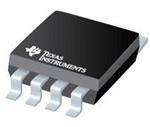
 Datasheet下载
Datasheet下载
